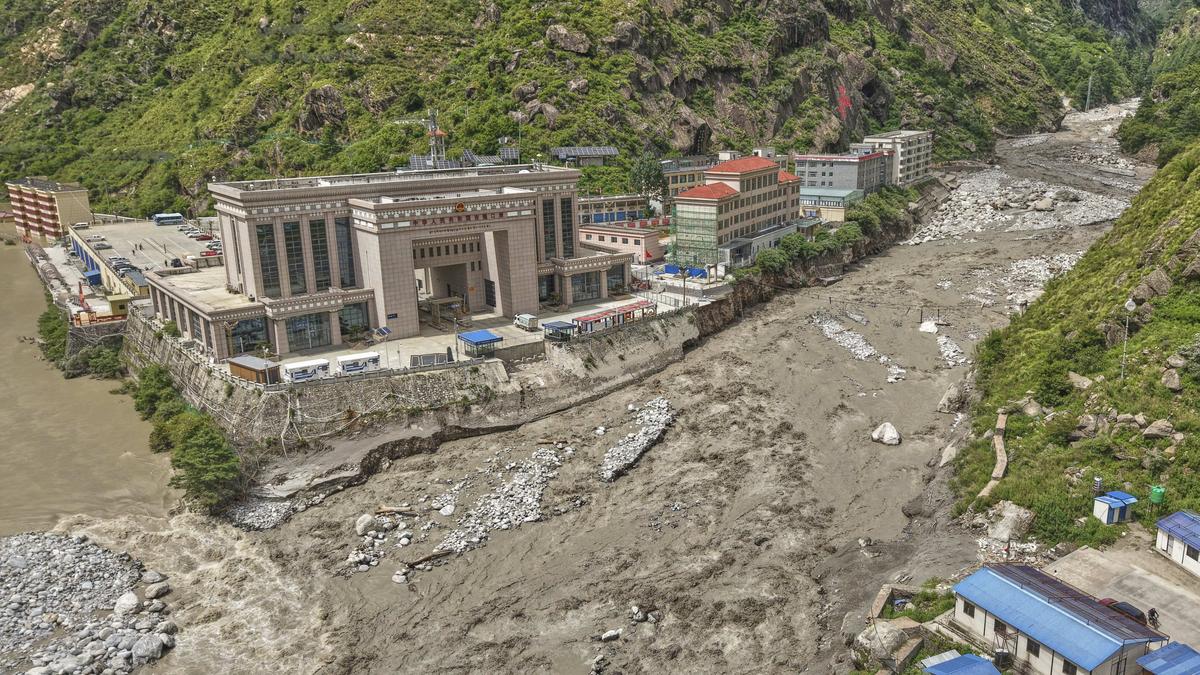Chinese land on left, and Nepalese land on right are seen after Friendship bridge, a key bridge over the Bhotekoshi River connecting Nepal with China was swept away in monsoon rain at Rasuwagadi, 120 kilometers (75 miles) north of the capital, Kathmandu, Nepal, on July, 9, 2025.
| Photo Credit: AP
The Trekking Agencies Association of Nepal (TAAN), an umbrella organisation of mountain tourism entrepreneurs, has reported that pilgrims travelling to Kailash Mansarovar are facing difficulties owing to the collapse of the Nepal-China Miteri Bridge near the Rasuwagadhi border point.
In a statement, TAAN general secretary Sonam Gyaljen Sherpa said the bridge was washed away by floods in the Lehende River on Tuesday morning (July 8, 2025), disrupting the movement of pilgrims en route to the sacred site.
Flood without rain in Nepal raises concerns about Glacial Lake Outbursts
Sherpa urged the Chinese government to take immediate diplomatic measures to facilitate the passage of pilgrims via alternative routes, including Tatopani, Korola, Hilsa, and other checkpoints.
The statement noted that both Nepali and foreign pilgrims travelling via Rasuwagadhi to Kailash Mansarovar —located in the Tibet Autonomous Region of China — are encountering significant problems following the destruction of the Miteri Bridge, which serves as a critical connection point between the two countries.
Eight dead, 31 missing in floods on China-Nepal border
With the pilgrimage season about to begin, TAAN has also called on Nepal’s Ministry of Foreign Affairs (MoFA) to engage diplomatically with the Chinese Embassy in Kathmandu to simplify and expedite the visa process. It urged the Ministry to “create an environment where pilgrims waiting in Kathmandu can travel to Kailash as soon as possible.”
Nepal is expected to host at least 25,000 Indian pilgrims this year for the revered Kailash Mansarovar Yatra, resuming after a five-year hiatus. On January 27, 2025, Chinese Vice-Foreign Minister Sun Weidong and Indian Foreign Secretary Vikram Misri held a bilateral dialogue in Beijing, during which both sides agreed to resume the Kailash Mansarovar pilgrimage for Indian nationals.
Nepal flash floods: Nine dead, many stranded; rescue efforts underway
The Indian government facilitates the Kailash Mansarovar Yatra via two official routes: the disputed Lipulekh Pass and the Nathu La Pass in Sikkim, both coordinated with Chinese authorities.
The Kumaon Mandal Vikas Nigam manages the Lipulekh route, while the Sikkim Tourism Development Corporation oversees the Nathu La option. These are pre-arranged, government-managed routes with fixed quotas. However, the majority of Indian pilgrims choose to travel privately via Nepal, with four main routes available: Tatopani, Rasuwagadhi, Hilsa, and the Kathmandu-Lhasa flight.
The Rasuwagadhi-Kerung route, operational since December 2014, became Nepal’s second major trade point with China after Tatopani. In 2017, it was upgraded to an international checkpoint, allowing cross-border travel with visas and passports. Since then, it has become the most cost-effective option for pilgrims heading to Kailash Mansarovar.
The annual pilgrimage season significantly boosts Nepal’s tourism sector and government revenue, as religious travellers fill hotels and restaurants and provide employment for travel agents, airlines, guides, and porters. The Kailash Mansarovar Yatra season typically runs from June to September.
Published – July 12, 2025 11:46 am IST
